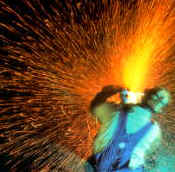
Many employees work at elevated temperatures in the work
environment with potential exposures for heat related illnesses.
Most heat stress exposures can be effectively managed with a program
that educates workers on symptoms of heat related illnesses and
corrective actions. Exposures can also be managed through effective
engineering controls that are designed for the heat sources present
in the workplace. While it is tempting to add fans and increase air
movement for tasks with elevated temperatures, often times this
approach is the least effective way to address the heat sources
actually present. To effectively manage heat exposures in the work
place, a heat stress survey should be conducted to identify heat
sources that are contributing to employee exposures.
Heat Stress measurements can be readily made
using a Wet Bulb Globe Temperature (WBGT) instrument to identify
heat sources for effective control. A WBGT instrument uses a
combination of temperature sensors to measure the Wet Bulb (WB)
temperature, Globe Temperature (GT) and Dry Bulb (DB) temperature. A
comparison of those temperatures can give indications on the types
of heat sources present in the workplace. Controls for a work
environment with a high DB temperature in excess of 95° F will need
different heat controls than a work environment heavily influenced
by radiant heat as evidenced by a high GT measurement. After
identifying the types of heat sources present and employee work
patterns and interactions, an effective Heat Stress Control program
can be implemented to minimize risks for heat related illnesses.
|